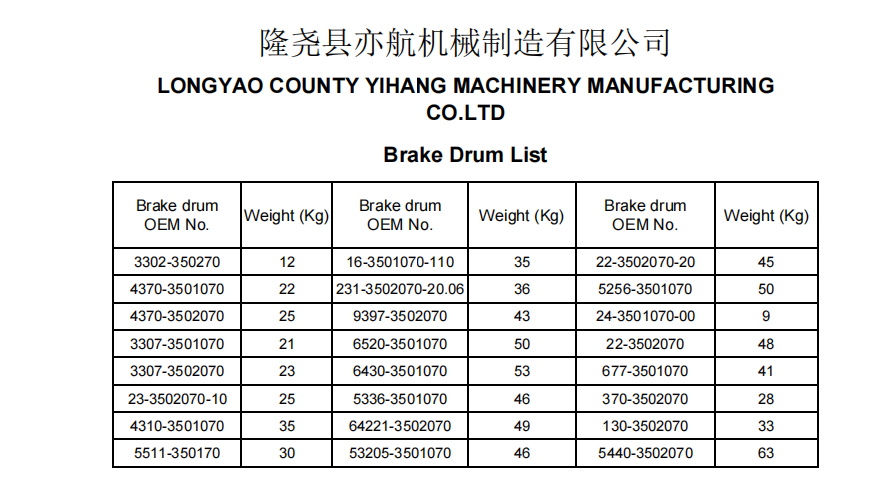Nov . 15, 2024 07:22 Back to list
lightweight brake drums
The Evolution and Advantages of Lightweight Brake Drums
In the ever-evolving landscape of automotive engineering, the quest for enhanced vehicle performance and safety has driven the innovative development of various components. Among these, lightweight brake drums have emerged as a crucial advancement, revolutionizing braking systems in modern vehicles. This article delves into the significance, advantages, and future potential of lightweight brake drums.
Understanding Brake Drums
Brake drums play a vital role in a vehicle’s braking system, serving as the component against which brake shoes press to create friction and slow down or stop the vehicle. Traditionally, brake drums were manufactured using cast iron, which, while effective, is heavy and can add unnecessary weight to the overall vehicle. This heft not only impacts fuel efficiency but also affects handling and performance.
The Shift to Lightweight Materials
With the automotive industry’s increasing focus on weight reduction to improve fuel economy and performance, manufacturers have begun exploring lightweight materials for brake drums. Common alternatives include aluminum, composite materials, and advanced iron alloys. These materials offer substantial weight savings while maintaining or even enhancing braking performance and durability.
Aluminum is one of the most popular choices for lightweight brake drums. It is known for its high strength-to-weight ratio, excellent thermal conductivity, and corrosion resistance. These properties enable aluminum brake drums to dissipate heat more effectively, reducing the risk of brake fade during prolonged use. Moreover, the reduction in weight contributes to improved acceleration, handling, and overall efficiency.
Composites, another innovative option, combine materials to leverage the strengths of each. For example, a composite brake drum may incorporate carbon fiber or other synthetic fibers to achieve a balance between weight and strength. This not only enhances performance but also allows for greater design flexibility, making it possible to create brake drums tailored to specific vehicle requirements.
Advantages of Lightweight Brake Drums
1. Improved Fuel Efficiency One of the most significant benefits of lightweight brake drums is the potential for improved fuel efficiency. By reducing the overall weight of the vehicle, less energy is required for acceleration, which translates into better mileage and lower emissions.
lightweight brake drums

2. Enhanced Performance Lighter brake drums contribute to improved vehicle dynamics. With reduced unsprung weight, handling and ride quality can be significantly enhanced. Vehicles can respond more nimbly to driver inputs, improving overall driving experience.
3. Reduced Stopping Distances Lightweight materials can lead to shorter stopping distances. The decreased mass allows for quicker deceleration, which is crucial for safety, particularly in emergency situations.
4. Longer Lifespan Advanced materials often possess a higher resistance to wear and heat. This can lead to longer-lasting brake components, reducing the frequency of replacements and thus lowering maintenance costs over time.
5. Environmental Benefits By promoting fuel efficiency and reducing emissions, lightweight brake drums contribute to a more sustainable automotive industry. These advancements align with global efforts to minimize environmental impact.
Challenges and Considerations
Despite the clear advantages, the transition to lightweight brake drums is not without challenges. The initial manufacturing costs for advanced materials can be higher compared to traditional materials. Furthermore, ensuring that lightweight components meet safety and performance standards is of utmost importance. Rigorous testing and validation processes are required to guarantee that these new materials can withstand the demands of high-performance driving.
The Future of Lightweight Brake Drums
The future of lightweight brake drums looks promising. With ongoing advancements in materials science and engineering techniques, we can expect to see even more innovative solutions emerge. As the automotive industry shifts towards electric and hybrid vehicles, the demand for lightweight components will only intensify. Manufacturers are likely to continue investing in research and development to create brake systems that offer not just performance and safety but also sustainability.
In conclusion, lightweight brake drums represent a significant step forward in automotive technology, providing a host of benefits including improved fuel efficiency, enhanced performance, and a lower environmental footprint. As the industry progresses, these components will undoubtedly play an essential role in shaping the future of vehicle design and functionality.
-
Scania Brake Drums: OEM Quality for Optimal Safety & Durability
NewsAug.16,2025
-
R.V.I: Advanced Remote Visual Inspection for Precision
NewsAug.15,2025
-
Discover HYUNDA: Innovative Vehicles, Equipment & Solutions
NewsAug.14,2025
-
R.V.I: Unlock Advanced Insights & Real-time Performance
NewsAug.13,2025
-
Kamaz Brake Drum: Durable & Reliable for Heavy Duty Trucks
NewsAug.12,2025
-
Heavy Duty Iveco Brake Drum - Premium Quality & Safety
NewsAug.11,2025
